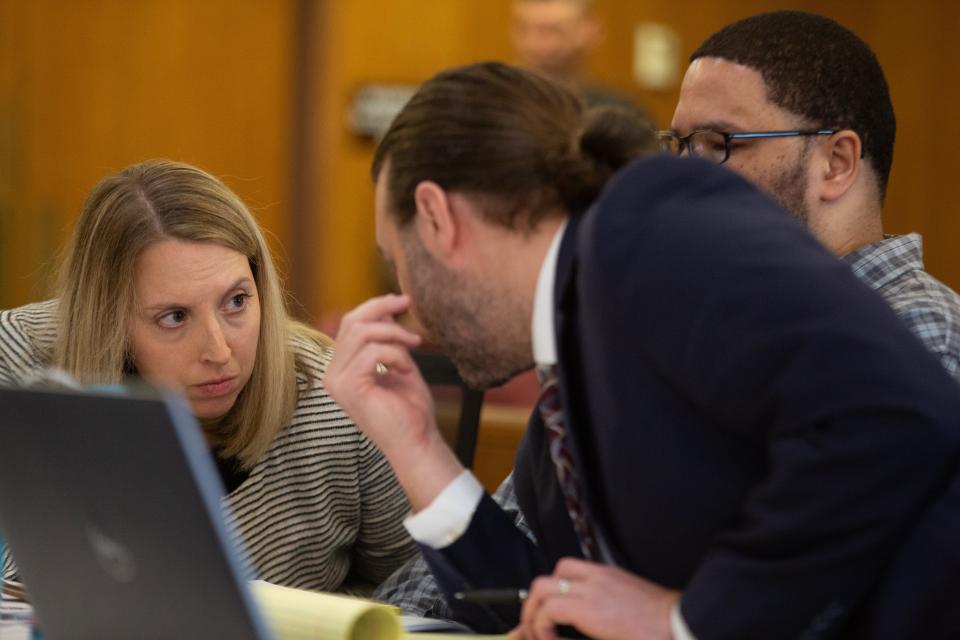Shawnee County judge denies capital murder defendant's bid to have all his charges dropped
A Shawnee County District Court judge rejected a request Monday that he dismiss the case against a capital murder defendant because 30 body camera videos taken by police regarding the case were accidentally deleted.
Judge Bill Ossmann denied a motion filed last December by attorneys representing Yanez Sanford, 41, who is charged in the 2016 killings of three people in southwest Topeka.
Sanford's attorneys contended the destruction of the videos left him unable to get a fair trial. Ossmann disagreed.
Sanford’s trial is set to start April 30.

What are the facts of the case?
Sanford faces charges that include capital murder linked to the 2016 killing of a man, a woman and an unborn child at Fairlawn Greens Apartments, immediately south of Topeka West High School at 5235 S.W. 20th Terrace.
Prosecutors say Sanford fatally shot Dominique Ray, 23; Camrah Trotter, 20, who was in her third trimester; and Trotter’s unborn daughter, who was to have been named Ariyah Trotter.
Camrah Trotter had also been raped, said District Attorney Mike Kagay.
When new evidence emerged after four years of investigation, Sanford was charged in September 2020 with crimes that included capital murder, court records say.
Capital cases require prosecutors to file a notice of intent if they plan to seek the death penalty, which hasn't been done in the case against Sanford.
Why did Sanford's attorneys ask the judge to dismiss the case?
Sanford's attorneys sought Dec. 13 to have all charges dismissed, saying Sanford could no longer get a fair trial because of the destruction of 30 Axon police body camera videos taken in 2016 as part of the investigation.
The body camera video and other evidence were ordered preserved in February 2021.
But police were then taken by surprise when the videos were destroyed later that year at the end of a planned five-year retention period, Deputy Topeka Police Chief Jamey Haltom testified at a January motion hearing in the case.
He indicated no one from the department contacted Axon or evidence.com to ask that the videos not be deleted because no one realized they were going to be deleted.
What legal precedents did the judge take into account?
Dan Dunbar — a retired Shawnee County chief deputy district attorney working as a special prosecutor on the case — wrote in a court document filed at 12:08 a.m. Saturday that for the charges against Sanford to be dismissed, his attorneys would need to meet standards set out by past U.S. Supreme Court rulings.
Dunbar wrote that the high court's ruling in the 1984 case of California v. Trombetta requires the defense to prove the missing body camera videos have potential exculpatory value; that exculpatory value to have been apparent before they were destroyed; and no comparable evidence to be available. Exculpatory evidence favors the defendant.
Under questioning from Ossmann, Emily Barclay, senior assistant capital defender with the state's Death Penalty Defense Unit, said Monday that two of the 30 videos were potentially exculpatory. She said the officers who wore those cameras interacted at the scene with a girl about 4 years old who said the killer was "white." Sanford is Black.
Dunbar wrote that the deleted videos from those two officers consisted primarily of interactions with that girl and an adult named Jamonetz Fulton.
"Both (the girl) and Fulton were subsequently safetalked and interviewed, all of which were recorded and provided to the defendant through the discovery process," Dunbar wrote. "The fact the recording officers have testified, are available to testify, have prepared narrative reports, and that (the girl) and Fulton have provided recorded statements taken by endorsed witnesses who are also available to testify, all constitute 'comparable evidence by other reasonably available means.'"
Regarding whether any exculpatory value of the videos may have been known before deletion, such value "would be prospective and speculative and therefore not apparent before deletion," Dunbar wrote.
What other legalities were considered?
In seeking to have charges against Sanford dismissed, Barclay also described all 30 deleted police videos as being "potentially useful."
In such situations, the Supreme Court's ruling in the 1988 case of "Arizona v. Youngblood" calls for judges to look at whether police had the videos destroyed "in bad faith" while knowing their potential exculpatory value, said the document Dunbar filed Saturday,
"Based on the testimony provided at the January 2024 motion hearing, what is clear is, none of the officers who were the recording officers had any knowledge the recordings were destroyed or even subject to destruction," he wrote. "Furthermore, since the purging occurred as the result of default setting and not at the hand of any person, how could one argue the deleting party knew of the potential usefulness of the recordings prior to the destruction."
What happens next?
Ossmann scheduled an April 17 preliminary hearing to take place in the case against Sanford.
Sanford's trial is expected to last about two weeks, attorneys for the two sides said Monday.
Contact Tim Hrenchir at threnchir@gannett.com or 785-213-5934.
This article originally appeared on Topeka Capital-Journal: Judge refuses to drop charges against Shawnee County murder defendant

